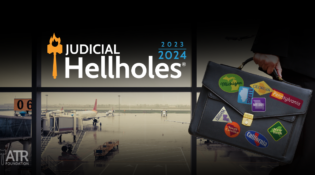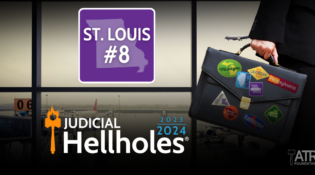The last time New Jersey was recognized as a full-blown Judicial Hellhole and not simply cited among this report’s Watch List jurisdictions, it was because a  single judge in Atlantic County was wreaking havoc on the state’s court system. That problem was fixed when the bad judge was kicked upstairs to an appellate court, but now there are new weeds growing and choking Garden State courts. The New Jersey Supreme Court has made a number of shocking decisions over the past few years, and the lower courts are following along in lock step.
single judge in Atlantic County was wreaking havoc on the state’s court system. That problem was fixed when the bad judge was kicked upstairs to an appellate court, but now there are new weeds growing and choking Garden State courts. The New Jersey Supreme Court has made a number of shocking decisions over the past few years, and the lower courts are following along in lock step.

New Jersey
GOING ROGUE ON ARBITRATION
The New Jersey Supreme Court took its first swipe at arbitration in late 2014 when it announced in U.S. Legal Services Group, L.P. v. Atalese that it will no longer consider arbitration agreements valid unless their text goes so far to explain what arbitration is, how it is different from a proceeding in a court of law, and that parties are waiving their right to bring lawsuit.
The United States Supreme Court chose not to hear an appeal of the Atalese decision but, in deciding a similar case from California, warned states in 2015 that arbitration contracts must be placed “on equal footing with all other contracts.” New Jersey failed to take the hint.
In Morgan v. Sanford Brown Inst., New Jersey’s high court again thumbed its nose at both the 91-year-old and frequently upheld Federal Arbitration Act and the highest court in the land. The New Jersey justices held that a contract’s arbitration clause, and the delegation clause that made it enforceable, where in fact unenforceable. The parties had agreed to arbitrate but had not additionally specified that they were agreeing not to have a trial by jury, and thus had failed to meet the standard announced in Atalese. Even as New Jersey’s high court acknowledged its obligation under the FAA to place arbitration agreements “on an equal footing” with other contacts and insisted that “no magical language is required to accomplish a waiver of rights in an arbitration agreement,” it nevertheless maintained that it is not sufficient to agree to arbitrate. An agreement must also explain what the parties are agreeing not to do. (We were scratching our heads, too.)
Unfortunately, New Jersey’s lower courts may now be confused, too, because some are effectively demanding “magical language.” In Defina v. Go Ahead and Jump 1, LLC, an appellate court struck down an arbitration clause that read as follows:
I on behalf of myself and/or my child(ren) hereby waive any right I and/or my child(ren) may have to a trial and agree that such dispute shall be brought within one year of the date of this Agreement and will be determined by binding arbitration before one arbitrator to be administered by JAMS pursuant to its Comprehensive Arbitration Rules and Procedures.
The court noted that the clause plainly waived the signer’s right to a “trial.” But because it didn’t include the word “court” nor explain that arbitration conducted by one arbitrator does not constitute a jury, it was condemned as unenforceable. Seriously?
In Anthony v. Eleison Pharmaceuticals, LLC, a different appeals court held that an arbitration agreement in a high-level employee contract was insufficiently clear because it “included no reference to a waiver of plaintiff’s statutory rights or a jury trial.”
So if Garden State courts are not insisting on the inclusion of certain magic words in arbitration agreements before they’ll see fit to enforce such agreements, what are they doing? It’s hard to know. But if they continue wandering down this dark path, businesses will have no way to know whether their arbitration agreements will be honored, and some may consider relocating to states with courts that are willing to set clear standards and stick to them.
CONTRACT, SCHMONTRACT
Believe it or not, the New Jersey Supreme Court’s disdain for seemingly lawful contracts makes its displeasure with arbitration clauses look mild by comparison. For example, in Rodriguez v. Raymours Furniture Co. the court unanimously invalidated an employment contract that set its own time limit for bringing lawsuits, substituting the court’s own policy preferences for those agreed to by the parties in the case.
This unprecedented decision flies in the face of prior New Jersey case law, and even makes the Judicial Hellhole across the Hudson River look good by comparison. Because when the exact same contract provision was challenged in New York, it was upheld. And if New Jersey’s justices persist in their disdain for businesses and individuals whose incomes rely on their contracts being honored as written and freely entered into, New Jersey may need a heckuva lot more than traffic cones to slow the possible exodus of commerce and tax revenue fleeing the state.
INVITING EXPERIMENTATION
If the decisions detailed above lead one to believe that New Jersey’s high court is unwilling to set, much less stick to, bright-line rules, its 2016 decision in Schwartz v. Accuratus Corp., a take-home toxic torts case, should confirm that belief.
Ten years ago when the court addressed the issue of claims involving exposure to toxic substances allegedly brought home from work on employees’ clothes, it suggested it was setting a bright-line rule. The court dismissed concerns that expanding the law to cover take-home claims would lead to open-ended liability saying:
Although [the defendant fears] limitless exposure to liability based on a theory of foreseeability built on contact with [the plaintiff’s] asbestos-contaminated clothing, such fears are overstated. The duty we recognize in these circumstances is focused on the particularized foreseeability of harm to plaintiff’s wife.
Fast forward to 2016 when the U.S. Court of Appeals for the Third Circuit asked, in a certified question, whether a girlfriend, who would sometimes wash her boyfriend’s work clothes when she stayed overnight at his apartment, could seek compensation under the state’s existing standard.
Garden State justices might simply have said “yes.” But their mind-numbing answer instead has served to make take-home liability virtually limitless. Writing for a unanimous court (!) Justice Jaynee LaVecchia said:
The Court cannot define the contours of the duty owed to others in a take-home toxic-tort action through a certified question of law. While there may be situations in which household members are in contact with toxins brought home on clothing, a refined analysis for particularized risk, foreseeability, and fairness requires a case-by-case assessment in toxic-tort settings. Although the Court cannot predict the direction in which the common law will evolve, the Court identifies certain factors that will be important as such cases present themselves. In sum, the duty of care recognized in [2006] may extend, in appropriate circumstances, to a plaintiff who is not a spouse. The assessment should take into account a weighing of the factors identified herein to determine whether the foreseeability, fairness, and predictability concerns . . . should lead to the conclusion that a duty of care should be recognized under common law.
The court may as well have ordered the erection of two giant, flashing neon signs – one at the eastern end of the Delaware Memorial Bridge and one at the western end of the George Washington Memorial Bridge — inviting all friends, neighbors, drinking buddies, softball teammates, lovers, drycleaners and all other known acquaintances of anyone ever exposed to potentially toxic dust or fibers in a workplace to “SUE HERE!”
By refusing to set reasonable limits on take-home liability and announcing that it “cannot predict the direction in which the common law will evolve,” the high court is irresponsibly welcoming trial lawyers’ experiments. Their test subjects will be New Jersey businesses, which now have no way of knowing what sort of liability they may face, as well as deserving plaintiffs, whose recoveries will necessarily be reduced as the pie of available compensation funding is sliced into ever smaller pieces.
OUT-OF-STATE PLAINTIFFS STILL DRAWN BY LAX EXPERT EVIDENCE STANDARD
New Jersey is the proud home to many of the nation’s leading pharmaceutical and medical device companies. So it is not surprising that a lot of drug and device lawsuits are filed there. What is surprising is the sheer number of drug and device suits filed in New Jersey state court, and the percentage of those cases that are filed by out-of-state plaintiffs who would generally be expected to bring such claims in federal court.
Nothing better illustrates just how many drug and device lawsuits are working their way through the New Jersey courts than a quick look at the state’s multicounty litigation (MCL) system. As of late November 2016, there were 24,798 cases pending in 15 different drug and device related MCLs.
The most recent study done on all multicounty litigation, including cases that don’t involve drugs or devices, found that 9 out of 10 are filed by out-of-state plaintiffs. While New Jersey’s high court may not find this disturbing, many others, including the New Jersey taxpayers who provide finite court resources, do.
One reason litigants prefer New Jersey is the state’s standard for expert testimony. New Jersey Supreme Court Justice Barry T. Albin affirmed this during recent oral arguments in the Accutane litigation (see video transcript at the 1:25:10 mark), saying, “We apply our evidence rules and our court rules and that attracts plaintiffs here. They like our evidence rules, they like our expert witness rules,” as though becoming a destination for litigation tourists were something to aspire to.
The reason plaintiffs like the Garden State’s expert witness rules are because they are unique. Unlike the majority of all the other states and the federal court system, which rely on the time and trial-tested Daubert standard, New Jersey has its own standard. The problem with this is that a lack of case law on the subject leaves judges free to interpret and apply the standard as they see fit, leading to inconsistent rulings.
Plaintiffs are more willing to roll the dice on borderline cases when they think they may be able to adduce “junk science” evidence that other state courts would not allow. The New Jersey Supreme Court could put a stop to this abuse if it were willing to update New Jersey’s rules to mirror the federal rules and case law, but it has repeatedly refused to do so.
Of course, fairness compels this report to acknowledge that some New Jersey judges have fulfilled their gatekeeping responsibility when considering the admissibility of expert testimony. In September 2016 Atlantic County Judge Nelson C. Johnson properly dismissed two cases that alleged talcum powder use caused the plaintiffs’ ovarian cancer. Judge Nelson noted the “narrowness and shallowness” of the plaintiffs’ experts’ evidence, which “their peers in the scientific community would not rely upon.” Of course those same talc-causes-cancer “experts” have been welcome by judges with open arms in the Show Me Your Lawsuits State of Missouri, this year’s #1 Judicial Hellhole. They’re ringing up multimillion-dollar verdicts there faster than Turnpike traffic north of Exit 6.
LAWSUIT-GENERATING CONSUMER LAWS
Based on the leadership the New Jersey Supreme Court is providing (Not!), another legal storm may be brewing. For the past several years we have warned the New Jersey court system that its embrace of consumer litigation would overload its already bulging dockets. If these suits were helping consumers, it would be one thing. But the majority of such suits are a classic example of what ATRA general counsel and renowned tort law expert Victor E. Schwartz calls “empty suit” litigation. No one has experienced a true injury in these lawsuits, but the claims persist because they are money-makers for the lawyers who shamelessly gin them up.
Part of the reason attorneys have been able to exploit New Jersey’s consumer protection laws is the fact that they are poorly drafted. New Jersey’s non-partisan Law Revision Commission, which has been tasked with cleaning up the state’s Kafkaesque Consumer Fraud Act (CFA), admits the law is “infirm” and “one of the state’s most complicated statutes.” It’s confusing nature and ever-expanding boundaries have aided attorneys eager to expand their practice or get an upper hand in negotiations since no business owner wants to be branded a fraudster. And there is no telling how often consumer fraud lawsuits are merely threatened in pursuit of a make-this-go-away payoff before a lawsuit is file.
But an ATRF-commissioned study found that CFA lawsuits actually decided by courts increased 447% from 2000 to 2009. So New Jersey policymakers have obviously known for some time that there are problems with the states principal consumer protection law. Still they’ve done nothing to solve those problems.
Meanwhile, a previously obscure statute known as the Truth-in-Consumer Contract, Warranty and Notice Act (TCCWNA) has rapidly become a choice weapon that plaintiffs’ lawyers can wield against virtually any merchant “looking to sell in the Garden State.” Many of the key terms of this “gotcha” statute are undefined, leading to lawsuits over drink prices on menus, the definition of hardwood flooring, the phrase “void where prohibited” and the terms of service agreements on scores of websites. It truly is “a feeding frenzy [for] plaintiffs’ lawyers,” or as The Economist suggested, “class-action lawyers… may have struck gold.”
Nonetheless, policymakers and jurists have again been slow to react. In fact, as of this report’s publication, the New Jersey Attorney General’s Division of Consumer Affairs, the state agency tasked with enforcing consumer protection laws, doesn’t even mention TCCWNA on its website except in a copy of a consent agreement for a case in which TCCWNA claims were not central to the outcome.
Lawmakers are more to blame than courts when problematic statutes become a struggle to adjudicate. But the courts cannot and should not be let off the hook for the ongoing litigation boom. Whenever there has been an opportunity for the courts to crack down on victimless consumer lawsuits they have declined to do so. A unanimous New Jersey high court in 2013 went so far as to effectively declare that consumer protection statutes are remedial and thus should be read liberally, and that judges should take pride in expanding their application. And from that point on, as the nearby chart shows, TCCWNA litigation has soared.
As with arbitration and contract law, if New Jersey policymakers don’t find a fair and balanced way to protect both consumers and sellers of goods and services, without inviting excessive and unnecessary litigation, they will risk future economic job growth and job creation, to say nothing of being made the butt of late-night comedians’ jokes every time someone files a lawsuit because his sandwich was a bit too short or because Super Bowl tickets are expensive (duh!).
HOPE FLOATS
If there is any room for hope in this sad tale, it may be found in the fact that New Jersey’s courts are plainly led from the top. While that may seem counter-intuitive, consider this: For the first time in years New Jersey has no empty seats on its high court, and lower court vacancies are being filled. A full bench statewide should bring stability and take some pressure off the high court, whose justices may find time to take a breath and perhaps assess the overall health of the system they lead. The New Jersey Supreme Court has the power and the political capital to right the state’s precariously listing ship of civil litigation. It only needs the will to do so.
Latest News

Junk Science Front and Center in Recent Judicial Hellholes Verdicts
The changes to Federal Rule of Evidence 702 last year were supposed to be a watershed moment for expert testimony
Judicial Hellholes
Chicago Juries Continue to Reject Junk Science, Attention Turns to Delaware
This week, a Chicago jury delivered Zantac manufacturers their second straight victory, refusing to find them liable for causing a
Points of Light
Plaintiffs’ Lawyers in Judicial Hellholes® Set Sights on New Vital Industry
ATRF has long chronicled the plaintiffs’ bars constant efforts to find their next payday. From hot coffee to baby powder,
Judicial Hellholes
